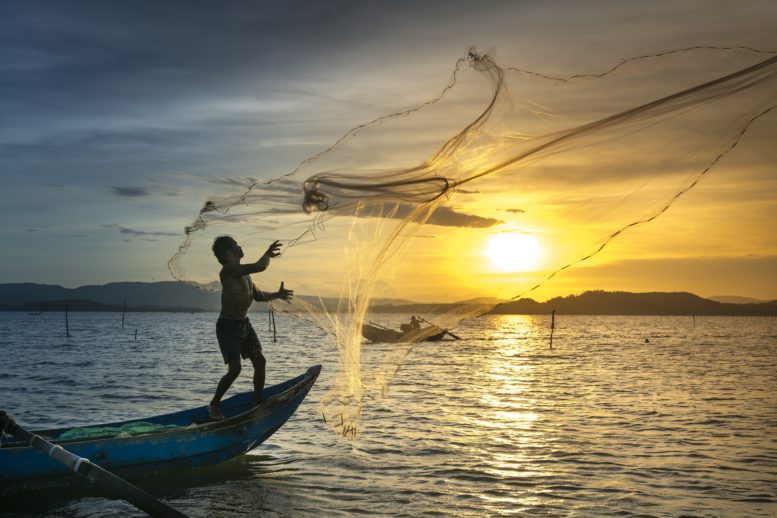National Fishery is composed of Commercial, Municipal, and Aquaculture Fishery. The Municipal Fishery sector is composed of Municipal Marine and Municipal Inland Fishery. Aquaculture is composed of Mariculture (Seaweed, Oyster, Mussel), Marine Fish Cage, Marine Fish Pen; Brackishwater Fish Cage, Brackishwater Fish Pen, Brackishwater Fish Pond; Freshwater Fish Cage, Freshwater Fish Pen, Freshwater Fish Pond; Small Farm Reservoir, and Rice Fish.
The annual average share of the main fishery sectors as a % of total Fishery value shows: Commercial Fishery, 27%; Municipal Fishery, 34%; and Aquaculture, 39%. These fishing sectors are distinct and separate, but they are actually competitors.
The 6 Major Fishing Grounds: West Sulu Sea near Palawan (30K sq km); Moro Gulf near Zamboanga del Sur, Maguindanao, and Sultan Kudarat (12.9K sq km); South Sulu Sea near Zamboanga del Sur, Sulu, and Tawi-Tawi (12.6K sq km); East Sulu Sea near Zamboanga del Norte and Negros (9.3K sq km); Sibuyan Sea near Aklan, Masbate and Romblon (8.1K sq km); and Bohol Sea (7.9K sq km).
The 7 Main Landing Fish Ports: GenSan, Navotas, Iloilo, Lucena, Zamboanga, Davao, and Sual receive 20% of fish landings. The rest land in small municipal ports. GenSan and Navotas receive majority of the landings for having more processing facilities nearby. The GenSan Fishport accounts for 42% of Total Marine Tuna landings. Marine Tuna is the largest export seafood commodity comprised of Bigeye, Frigate, Skipjack, and Yellowfin as the major Tuna species. Yellowfin is considered “Sashimi-grade” and highly sought after in the international market. Tuna export share however dropped by 6%, from 44% in 2014 to 38% in 2016. Shrimps and Tiger Prawn export share rose by 5% in the same period.
Over the period 2011-2016, herewith are the annual average volume and values of the Philippine Fishery production. The leading provinces with their main species of production by volume (Metric Tons), and by value (Php’000) are cited. Tables are provided such that the distant placers are also included for the purpose of identifying development areas for potential government support or private sector investment towards higher production growth and financial returns. Support may come in the form of grants, low interest loans, new drying and cooling facilities, low cost fingerlings; and fish meal and pellets, which are mostly imported. The lack of feeds impacts production level across all farmed species.
NATIONAL FISHERY
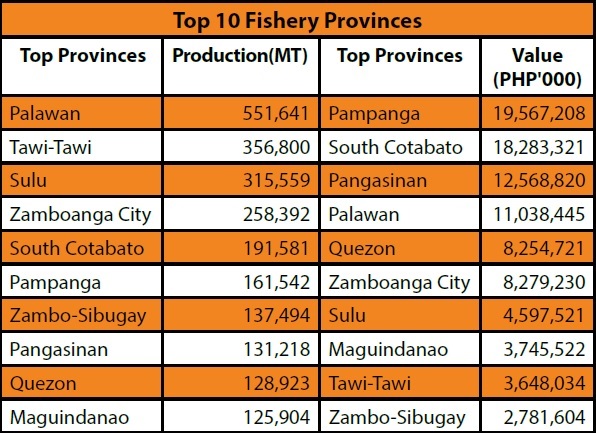
Palawan is the highest producer overall at 12% of Total Fishery. Tawi–Tawi and Sulu follow due to various aquaculture production. Pampanga brings in top value due to brackishwater mud crab, freshwater tilapia, rice fishery, and aquaculture; South Cotabato by marine tuna; Pangasinan by talaba and marine bangus; and Palawan by municipal marine and aquaculture. Not in the top 10 but Lanao del Norte brings in even higher return per unit. Total Fishery value is comprised of about 47% Marine Fishery and 53% Inland Fishery. National Fishery averaged 4.7M MT, and valued P236M.
COMMERCIAL FISHERY
The top producers in volume and value are South Cotabato and Zamboanga City due to Frigate, Skipjack, and Yellowfin Tuna. However, Indian Sardines (Tamban) is the top commercial fish produce, while Skipjack (Gulyasan) is the highest value contributor. Yellowfin Tuna generates the highest return per unit while Negros Occidental brings in the most value per unit. National Commercial Fishery averaged 1.1M MT, and valued P64M.
MUNICIPAL FISHERY
- The core of Municipal Fishery is Bigeyed Scad (Matambaka) at 6% of total Municipal Fishery. Palawan is the leading producer due to predominance in Municipal Marine fishery. National Municipal Fishery averaged 1.25M MT, and valued P80.5M.


- In Municipal Marine fishery, Palawan and Iloilo lead production and bring in the highest values. Although not in the top 10, Surigao del Sur generates a higher return per unit. Among the species, Yellowfin tuna brings in the highest return per unit. National Municipal Marine Fishery averaged 1.1M MT, and valued P71.6M.

- There are more high-producing provinces in Municipal Inland than in Municipal Marine, but smaller in tonnage and value. Rizal leads production, Maguindanao brings top value, and Cagayan generates the highest return per unit. Suso is the top produce, tilapia gives top value, and dalag offers the highest return per unit. National Municipal Inland Fishery averaged 195.6K MT, and valued P8.8M.

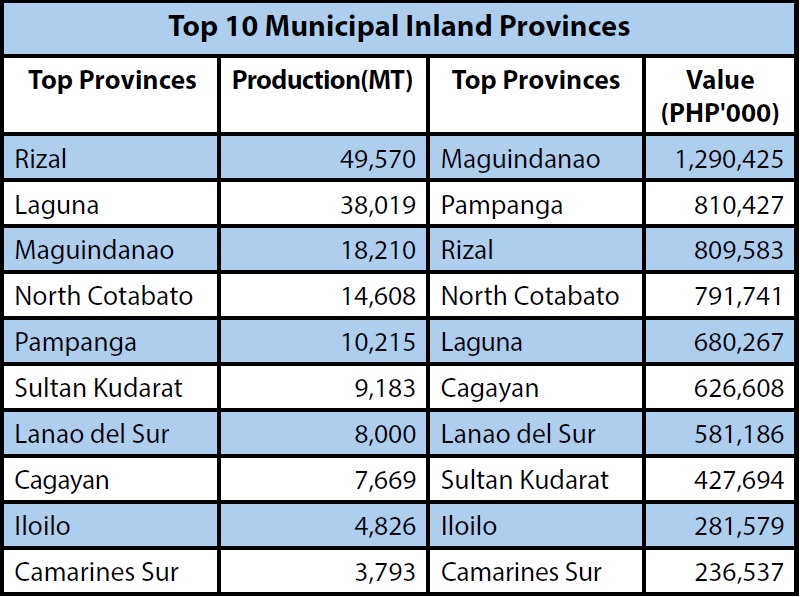
AQUACULTURE
The Autonomous Region in Muslim Mindanao (ARMM) tops in aquaculture production at 27% of total Aquaculture. The Liguasan Marsh and Bulusan Lake in Maguindanao are home to tilapia, catfish, and mudfish in fish cages and fish pens. But Central Luzon Region contributes the most value. By province, Palawan leads due to seaweed; Tawi-Tawi and Sulu follow. By value, Pampanga leads due to freshwater sugpo and tilapia; Pangasinan due to marine bangus; and Batangas due to tilapia and freshwater bangus. Bulacan and Negros Occidental bring in the highest value per unit. Seaweed is the top produce, Bangus brings top value, and tiger prawn and mudcrab generate the highest values per unit. The top 10 produce do not necessarily bring the relative value per unit. There might be more volatility in aquaculture. By value share, Brackishwater Fishpond holds the biggest share with an increase from 50% to 52%, while Seaweed has the biggest drop from 12% to 9%. National Aquaculture averaged 2.4M MT, and valued P91.7M.
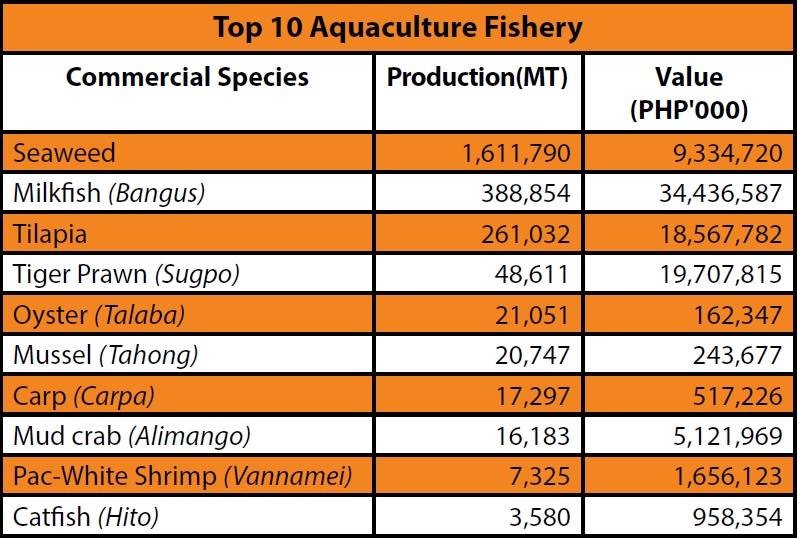
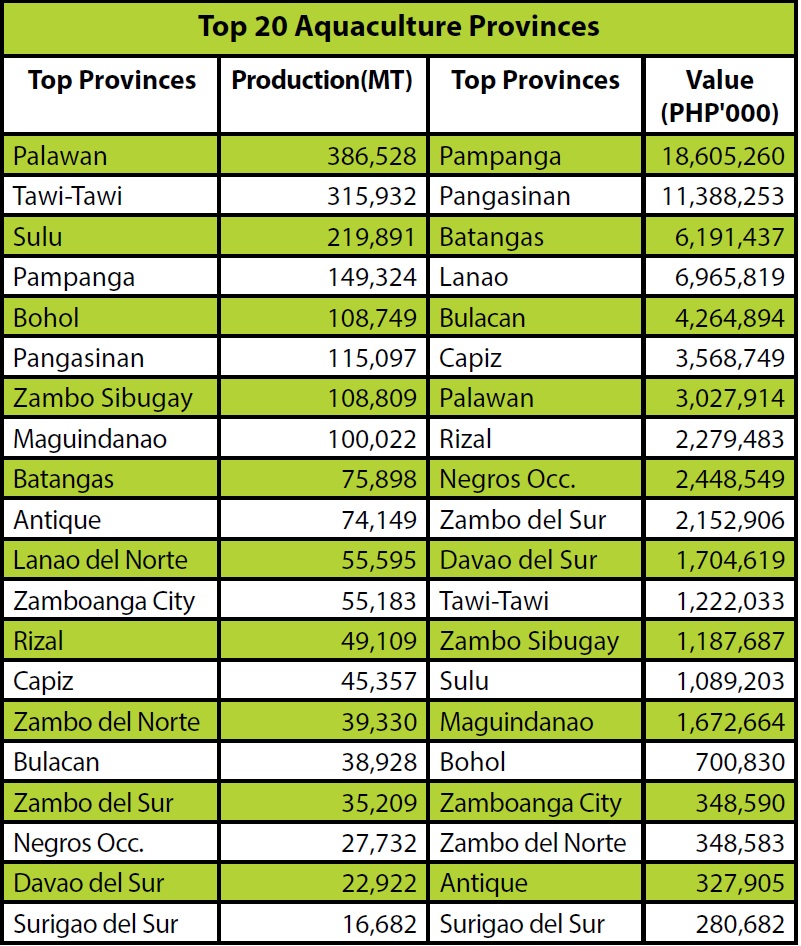
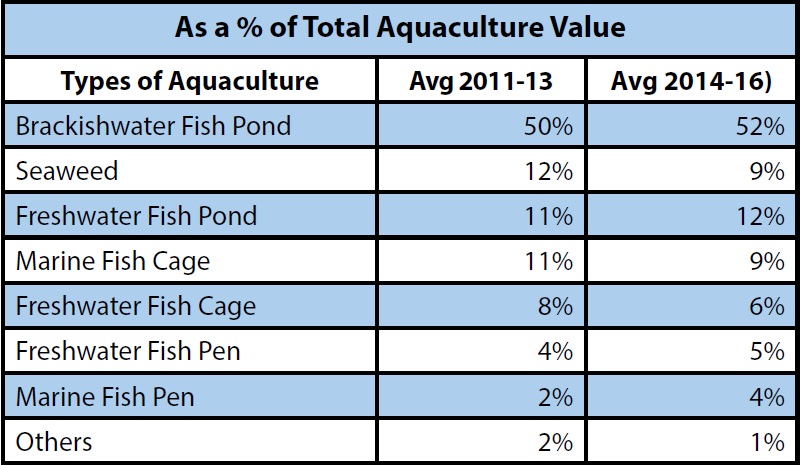
MARICULTURE
Talaba and tahong production are low compared to seaweed, but their contributing values are increasing.
- Talaba is most prevalent in Capiz and Bulacan, and both contribute the highest value. But Aklan at 8th place brings in the highest return per unit. National Oysters averaged 21.1K MT, valued P179M. Oysters are 1.3% of total Mariculture value.

- Tahong is prevalent in Capiz, Samar, and Cavite although their contributing values are in the reverse order. Metro-Manila brings in the highest value per unit. National Mussels averaged 20.7K MT, valued P243.7M. Mussels are 1.3% of total Mariculture value.

- Seaweed takes the lead at 67% of national Aquaculture. Palawan, Tawi-Tawi, and Sulu are the top producers, and the highest value contributors. Camarines Sur generates the highest return per unit although it ranks 14th place. Seaweed is prevalent in many provinces, thus, contributes a high value overall despite a downward trend in production. National Seaweed averaged 1.6M MT, valued at P9.3M. Seaweed is 97.4% of total Mariculture value.
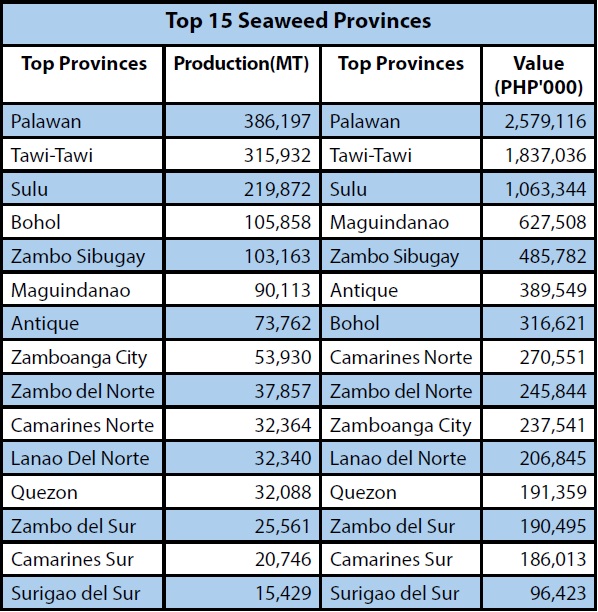
MARINE FISHERY
- The core of Marine Fish Cage is bangus at 99% of total Marine Fish Cage. Pangasinan is the top producer of marine bangus, and the highest value contributor as well. Davao del Sur is a distant follower. By value, Sarangani brings in the highest value per unit, thus South Cotabato moved down a notch. Not in the top 10 is Negros Occidental with an even higher return per unit. National Marine Fish Cage averaged 99.7K MT, and valued P10.8M.

- The core of Marine Fish Pen is bangus at 99% of total Marine Fish Pens. Pangasinan is the top producer and highest value contributor. Davao del Sur is a far second. Surigao del Norte leads in spiny lobster and grouper, and brings in the highest value per unit. National Marine Fish Pen averaged 17.4K MT, and valued P1.8M.
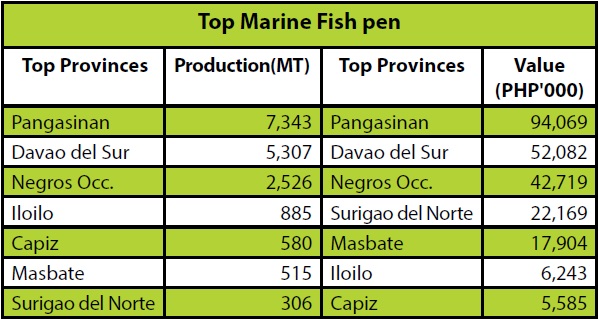
- By species, Indian Sardines (Tamban) leads in Marine Fishery, while Skipjack (Gulysan) contributes top value. Yellowfin Tuna (Tambakol) brings in the highest return per unit. Not in the top 10 but Spanish Mackerel (Tanigue) generates an even higher return per unit. Total Marine Fishery averaged 1.7M MT, and valued P109.7M.
BRACKISHWATER FISHERY
- The core of Brackishwater Fish Cage is bangus at 80% of total Brackishwater Fish Cage. Agusan del Norte is he top producer and the highest value contributor. Cagayan is a distant second but leads in tilapia. Ilocos Sur brings in the highest return per unit. National Brackishwater Fish Cage averaged 976 MT, and valued P109.8M
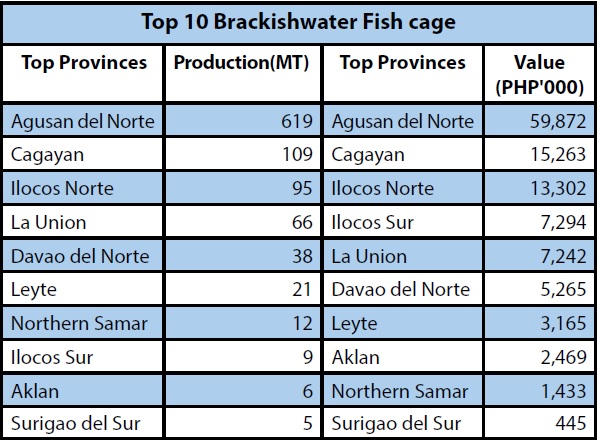
The core of Brackishwater Fish Pen is bangus at 96% of total Brackishwater Fish Pen. La Union is the top producer and the highest value contributor. Aklan is a far second. Samar and Ilocos Sur bring in the highest values per unit; and Biliran loses its 10th place to Iloilo’s higher value generation. Not in the top 10 is Siquijor but brings in an even higher return per unit. National Brackishwater Fish Pen averaged 1.1K MT, and valued P108.6M.
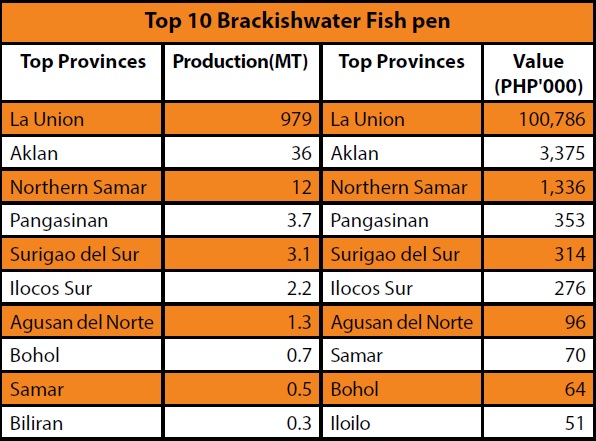
The core of Brackishwater Fish Pond is bangus, but sugpo, mud crab, and tilapia also have high levels of volume and value. By share: bangus is 48%, sugpo 15%, mud crab 5%, and tilapia 5% of total Brackishwater Fish Pond. Pampanga is the main producer of sugpo, mud crab, tilapia, and bangus, and the highest value contributor overall. Lanao del Norte leads in sugpo and mud crab. Zamboanga del Sur leads in tiger prawn. Capiz and Sorsogon lead in bangus and tilapia. Pangasinan and Bulacan are high producers of sugpo and bangus. Iloilo, Negros Occidental and Quezon are also high producers of bangus. Misamis Occidental brings in the highest value per unit overall. National Brackishwater Fish Pond averaged 323K MT, valued P48.1M.
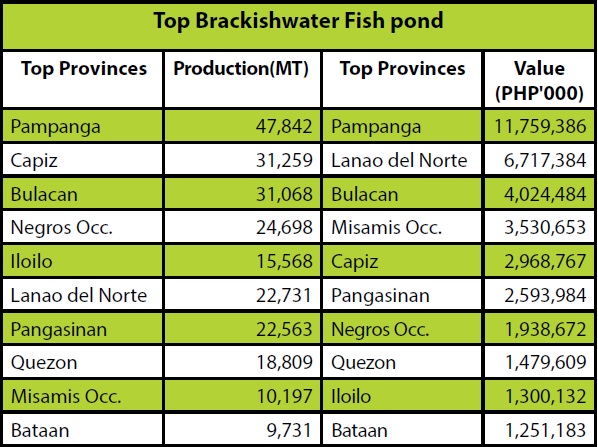
FRESHWATER FISHERY
- The core of Freshwater Fish Cage is bangus and tilapia, at 85% and 17% of total Freshwater Fish Cage, respectively. Batangas is the lead producer and highest value contributor due to bangus and tilapia. Laguna and Camarines Sur follow. Rizal and Laguna lead in carp production. Albay and Benguet bring in the highest returns per unit, while Metro-Manila loses its 8th place to Maguindanao. National Freshwater Fish Cage averaged 97.4K MT, valued at P19M.
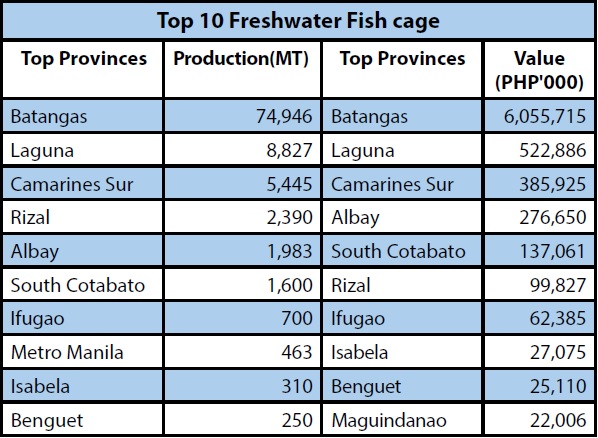
- The core of Freshwater Fish Pen is bangus, tilapia and carp at 40%, 34% and 24% of total Freshwater Fish Pen, respectively. Rizal leads tilapia, bangus and carp production, and contributes the highest value overall. Sultan Kudarat, and Maguindanao follow. Outside the top 5, the rest pale in comparison. By value, Maguindanao brings in the highest return per unit. National Freshwater Fish Pen averaged 41.3K MT, and valued P3.4M.
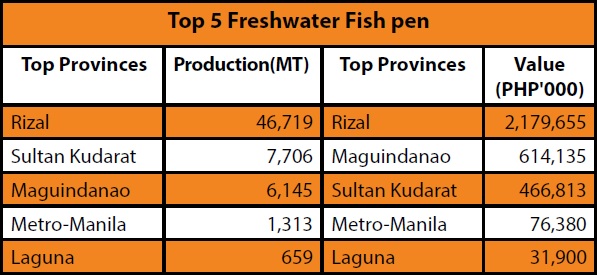
- The core of Freshwater Fish Pond is tilapia, comprising 98% of total Freshwater Fish Pond. Pampanga leads in tilapia production, as well as in value contribution. Isabela and Iloilo bring in the highest value per unit. Not in the top 10 are Nueva Viscaya and Ifugao but they contribute even higher returns per unit. National Freshwater Fish Pond averaged 146.2K MT, and valued P10.4M.
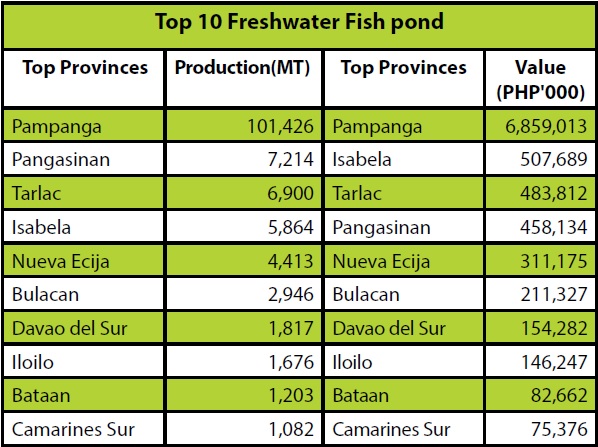
SMALL FARM RESERVOIR
The core of Small Farm Reservoir is tilapia and hito at 84% and 5% of total Small Farm Reservoir, respectively. Quirino takes the lead due to tilapia and mudfish, and is the top value contributor as well. Pampanga is a close second for producing more types of fish (tilapia, hito, and gourami). By value, Cagayan at 5th place brings in the highest value per unit. But Negros Occidental although at 13th place, generates an even higher return per unit. National Small Farm Reservoir averaged 173 MT, and valued P12.3K.
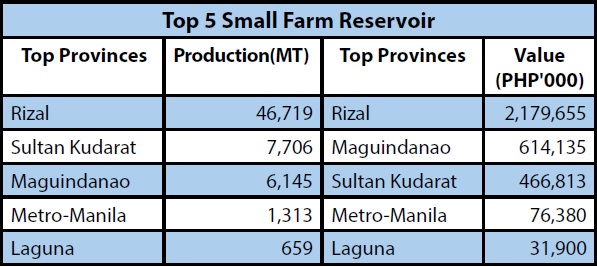
RICE FISHERY
The core of Rice Fishery production is tilapia at 81% of total Rice Fishery, which as a subsector of aquaculture is even smaller than Small Farm Reservoir. Pampanga takes the lead in Rice Fishery in volume and value, and is worth citing for producing 82% of total Rice Fishery comprising all the main species –tilapia, carp, catfish, mudfish, and gourami. By value, Iloilo brings in the highest return per unit. National Rice Fishery averaged 24 MT, and valued P1.4K.
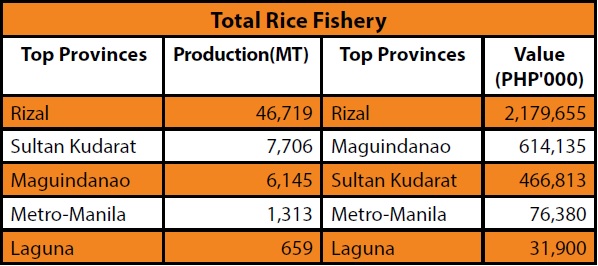
TRENDS AND RECOMMENDATIONS
In 2017, Total Fisheries decreased slightly by 1.1%. Commercial fisheries decreased by 10.9% and Municipal fisheries decreased by !%, while Aquaculture improved 5% in its harvests. Tuna accounted for 87% of total fish landings at GenSan Fishport amounting to 210,761 MT.
By mid 2018, Total Fisheries production registered 1.133K MT, or 2.6% higher than mid 2017. Commercial fishery improved by 2%, Municipal Marine fishery declined by 3.4%, Municipal Inland fishery improved by 4.3%, and Aquaculture improved 5.8%. Of the major species, milkfish, yellowfin tuna, roundscad and tiger prawn outputs decreased, of which the highest decrease was in yellowfin tuna by 15%. In contrast, seaweed, tilapia and skipjack outputs increased, of which the highest increase was tilapia by 14%. The GenSan Fishport again takes the lead in Commercial fishery at P18M or 31% of total Fishery. Currently, the Philippines is the leading exporter of high-grade Yellowfin Tuna to the European Union despite depletion of stock. According to the United Nations Food and Agriculture Organization’s State of World Fisheries and Aquaculture 2018, the Philippines rose to 10th place from 12th in marine capture production despite a 4.3% decline in volume, overtaking Chile and Myanmar.
There is a strong rationale to further support the increase in Seaweed production: Climate Change. The latest finding is that Seaweed can absorb CO2 from the air and trap CO2 in the water. Seaweed can capture CO2 20 times more than land forests can. The vast Amazon Forest captures 2 billion tons of CO2 per year. Imagine what vast farms of large Kelp seaweed can do. Reducing CO2 levels helps to combat the effects of global Climate Change. In addition, Seaweed serves as habitats for marine life, reduces ocean acidity, provides us a highly nutritious food source, and can be turned into biodegradable packaging.
Sources of Statistical Data: DA-BFAR, Bureau of Agricultural Statistics (BAS), Fisheries Statistics Division; and Philippine Statistics Authority.
